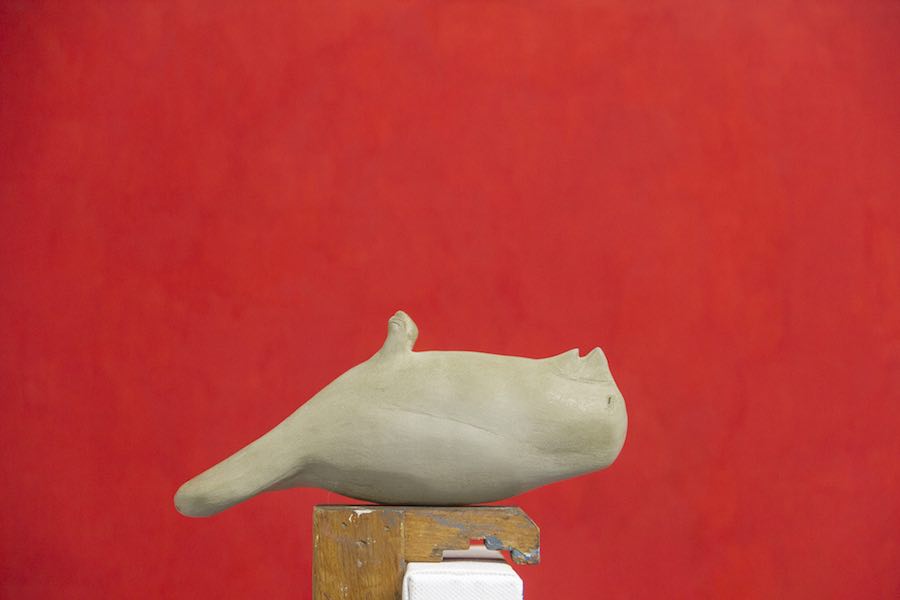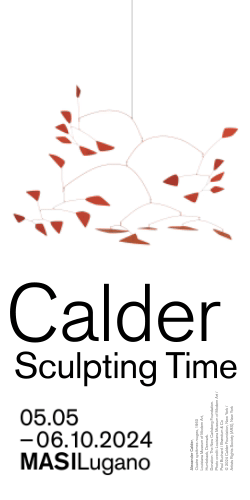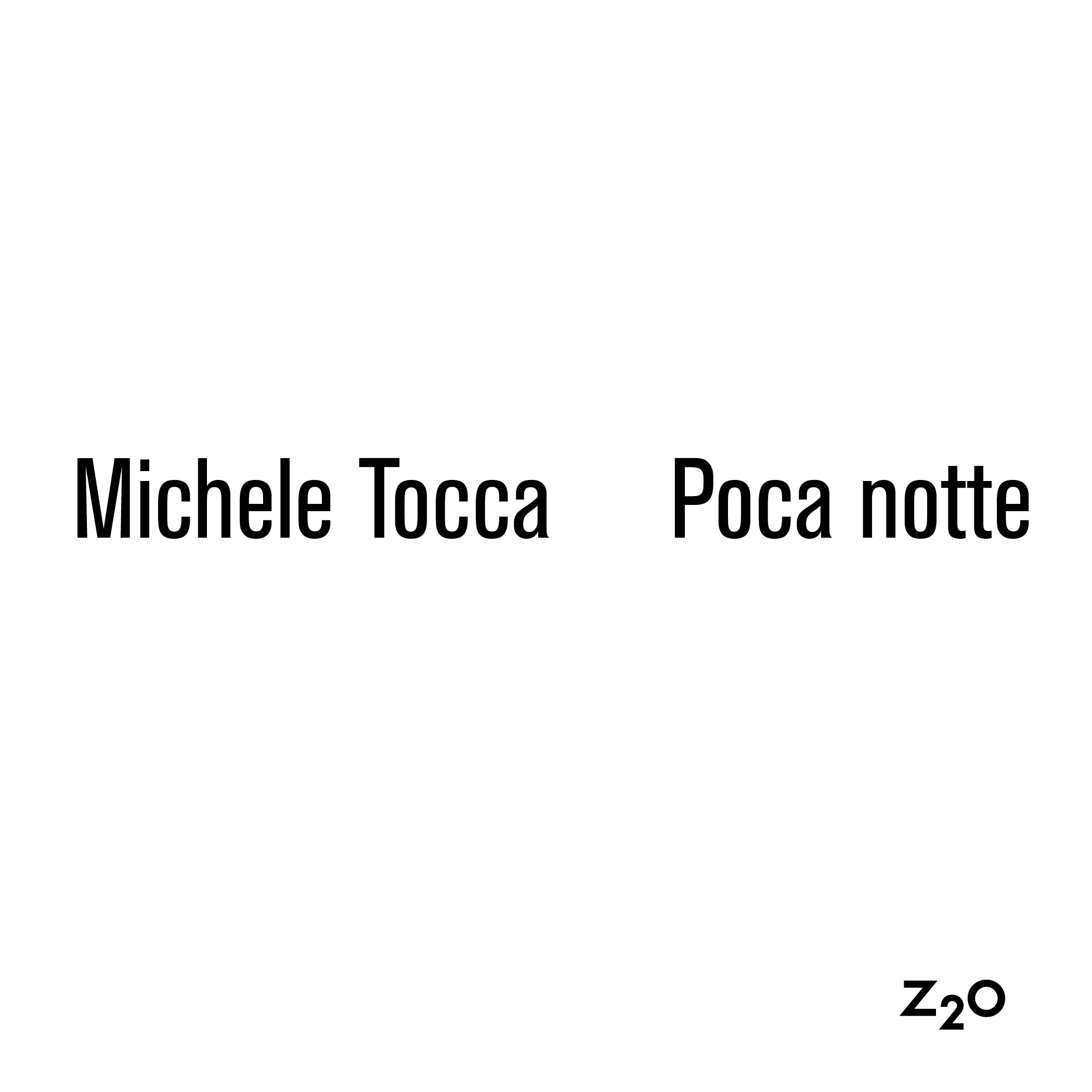

English text below —
A cura di Montecristo Project – Enrico Piras – Alessandro Sau–
Free thoughts of animals on the origin of the work of art and viceversa Fino a 11-12-2022
Montecristo Project, Sardegna, Italia
Deltitnu è il titolo di una nuova ricerca del Progetto Montecristo. Con il termine Meta-exhibitions si indica una serie di mostre sperimentali che mescolano elementi visivi e narrativi per affrontare temi come l’origine dell’opera d’arte, il suo rapporto con il mondo dell’arte e i personaggi che vi gravitano intorno. Il progetto comprende mostre i cui testi di presentazione sono dialoghi tra le opere stesse che svelano una narrazione che inizia con un misterioso omicidio.
Nei vari capitoli che compongono il progetto, di cui questo che segue è il prologo e primo atto, è presentato il percorso del giovane artista Deltitnu (un uccello di creta cruda) e i suoi incontri con diverse figure (artisti, curatori, intellettuali, critici, registi ) che si occuperanno della sua opera, ma soprattutto delle dinamiche che ne regolano la legittimità, le modalità di presentazione e di attribuzione del valore.
Nel primo capitolo il dialogo avviene nella cornice di una visita in studio in cui Deltitnu mostra e discute le sue opere con un papero-curatore che ha contattato per provare a presentare per la prima volta la sua ricerca a un professionista del sistema dell’arte. .
In questo progetto la fotografia delle opere assume un ruolo visivo e narrativo legato non solo alla classica inquadratura installativa, ma è volta a fondere gli elementi “attivi” e “passivi” dello spazio espositivo al fine di mettere in scena una conversazione visiva tra le opere agendo nel progetto.
PROLOGO
UCCELLINO: Il mio nome è Deltitnu e sono morto. Il mio cuore non batte più; solo il mio assassino sa cosa mi è successo; sono tre giorni che manco dal mio studio; neppure so più se qualcuno mi aspetti.
Ho avuto una vita felice; trovai presto la fama come artista, ma commisi il grave errore di considerare l’arte come un lavoro; talento, ispirazione e maestria non sempre trovano giusta ricompensa nel denaro; solo quando ho incontrato tragicamente la morte ho capito che la ricompensa dell’arte è l’arte stessa.
E’ un fatto miracoloso che voi possiate sentire la mia voce nonostante la mia situazione; sono morto ma non sono stato sepolto, per cui la mia anima non ha potuto abbandonare del tutto il corpo. Per questa mia particolare situazione ho dunque deciso di raccontarvi la mia storia.
State bene attenti ed aprite occhi ed orecchie.
Dietro la mia morte c’è stato uno scandaloso complotto.
L’ultima cosa che ho visto prima di morire è stata la coda del mio assassino.
Come tutti gli artisti sono morto, ma non scomparso.

CAPITOLO I
DOVE DELTITNU INCONTRA LA PAPERA PER IL SUO PRIMO STUDIO VISIT
Ero molto emozionato per il mio primo studio-visit con una figura così importante. Avevo preparato lo studio con cura esponendo i lavori migliori; sapevo che questa non era certo una professionista di sottordine, anzi, aveva molta influenza sulle scelte del direttore.
Avevo visto la mostra da lei curata poco tempo prima della sua visita ed ero proprio contento che avesse deciso di rispondere alla mia e-mail. Per l’occasione avevo preparato i miei deliziosi biscottini e allestito una piccola mostra nel mio studio con i miei migliori lavori.
Ciò che segue è quanto ricordo della nostra prima conversazione.
Papera: Ciao Deltitnu, sono felice di conoscerti di persona. E’ stato ragionevole da parte tua invitarmi a vedere il tuo lavoro. Avevo molti impegni, ma ho fatto il possibile per essere qui. Quest’anno sono continuamente in viaggio, parto domani per la Biennale di Venezia e ho decine di interviste e studio visits da fare.
DELTITNU: E’ un piacere averti qui, grazie per essere riuscita a venire a vedere anche il mio studio. Gradisci qualcosa? Ho dei deliziosi biscottini.
P: No. Non ho molto tempo, andiamo subito a occuparci del tuo lavoro. Ho dato uno sguardo al portfolio che mi hai inviato; mi sono sembrati dei buoni lavori, ma ho proprio bisogno di vederli dal vivo.
D: Eccoci nello studio, io comunque i biscottini li ho portati. Spero non sarai troppo severa nel giudicare il mio lavoro.
Nei minuti seguenti ci fu come un muto colloquio tra lei e le mie opere. Ne seguì un suo strano verso, che io non compresi.
Decisi di rompere il silenzio per chiederle cosa pensasse delle mie opere; ma mi sentii poi spinto a dirle qualcosa di personale, qualcosa su di me e sulle mie opere.
Ancora oggi non so perchè lo feci.
D: Spesso non riesco a lavorare, e faccio e rifaccio, fino a rigettare l’opera. Queste tele e sculture sono nate invece di getto. Quando le ho realizzate stavo molto male, volevo forzarmi a non dover pensare. Così nascono queste strane figure. Hanno qualcosa in comune con la morte. I due faccioni sorridenti sono come complementari, e penso siano fratelli. Ma questi non mi fanno così paura quanto l’immagine del guerriero, che ho ritratto a carboncino, a matita e a tempera. Lui è del tutto un’immagine nata dalle mie angosce. Penso sia un guardiano, un antico guerriero. E’ un’immagine simile al tempo. In realtà ogni immagine è simile a tutto il tempo, però è come se mi aspettassi che questo faccione cupo, prima o poi, iniziasse a parlare con me e a canzonarmi. E poi….
Mi interruppi. Il viso della papera era leggermente contratto, una leggera smorfia del labbro rivelava un fastidio non più sopportabile.
P: Sei noioso, c’è troppo sentimentalismo e troppa letteratura in quello che dici, devi essere più semplice, meno parli meglio è. Le opere sono poi molto diverse rispetto alla documentazione che mi hai inviato. C’è del potenziale, ma dobbiamo lavorarci molto assieme.
Sbiancai. Questa fredda risposta mi lasciò spiazzato. Ebbi il bisogno di sedermi, ma l’unica sedia nello studio era già occupata dalla papera.
P: Hai già mostrato queste opere a qualcuno, prima di me? L’oca le ha viste?
D: No, sei la prima a cui le mostro; a lei le avrei fatte vedere solo più avanti, è una ricerca questa che non è ancora del tutto conclusa.
P: Ma sei sicuro che sia una buona idea mostrarle all’oca? Io e lei non lavoriamo certo con gli stessi artisti; se fosse così non potrei mai presentarti al direttore.
D: Perché?
P: Non sono autorizzata a dirtelo.
Mi scusai con lei.
P: Vedi caro Deltitnu, esistono delle regole non scritte. Ci sono tanti artisti e tanti curatori, ma non tutti si muovono allo stesso livello. Nel sistema dell’arte ci sono le alte sfere, ma anche quelle basse e di sottordine: a queste ultime è bene non avvicinarsi mai se si vuole avere a che fare con me. Tu ad esempio vai alle inaugurazioni del direttore? Non ti ho mai visto e lui ci tiene molto a che gli artisti vivano le istituzioni.
D: No, non sapevo fosse così importante e quasi necessario. E invece delle opere che ne pensi? Possiamo parlare anche della mia ricerca?
P: Ma allora non hai capito. Stiamo già parlando della tua ricerca. Tu sostieni di essere un artista, ma al tempo stesso non conosci le regole dell’arte.
Rimasi interdetto. Mi ricordai allora dell’unico catalogo di una mostra di una certa importanza a cui avevo partecipato e pensai di mostrarglielo.
Lo trovai sotto un ripiano, ma poi mi sembrò come una testimonianza svilevole della mia ricerca. Tolsi dunque le mani dal libro e lo lasciai lì.
In quel momento mi girai e trovai la papera che mangiava voracemente i biscottini senza proferir parola.
P: Non capisci che sono l’unica che ti può aiutare? Ci sono, tuttavia, delle condizioni. Se l’oca dovesse presentare il tuo lavoro ti faresti terra bruciata attorno, il direttore ne ha una scarsissima considerazione. E’ questo quello che vuoi?
D: No di certo, ma tu mi potresti presentare al direttore?
P: No. Solo quando lo vorrà lui. Il mio compito è conoscere e osservare gli artisti e il loro lavoro, riportare poi ai gradi più alti delle sfere dell’arte quello che ho visto. Loro, poi, decideranno.
Ciò che è certo è che sei proprio ingenuo. Devo assolutamente aiutarti ad apparire più contemporaneo. Devi essere più collaborativo, ti devi fidare di me.
A quelle parole mi sentii a disagio. Mi sembrò di aver perso la mia grande occasione. Avevo lavorato davvero tanto a quelle opere e la papera mi fece sentire stupido e inadatto. Pensavo di sapere qualcosa dell’arte, ma da questo incontro mi fu chiaro che non era assolutamente così.
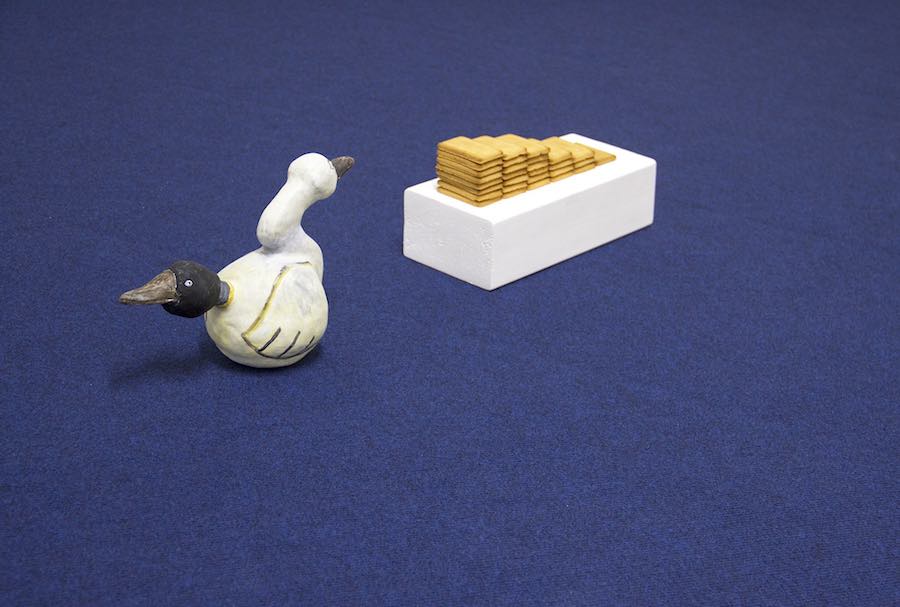
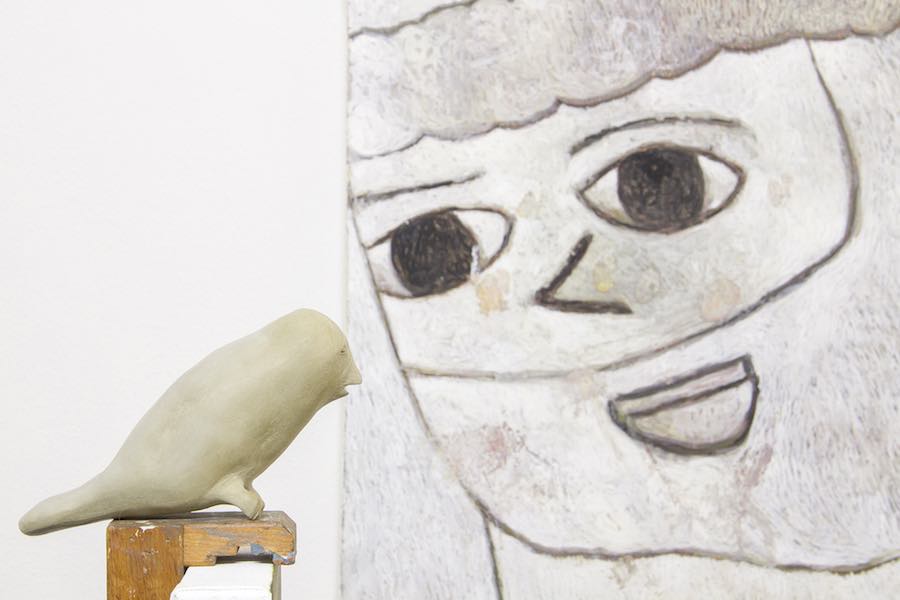
MONTECRISTO PROJECT | DELTITNU
Free thoughts of animals on the origin of the work of art and viceversa Until 11-12-2022
Curated by Montecristo Project (Enrico Piras – Alessandro Sau)
Deltitnu is the title of a new research opening at Montecristo Project. The term Meta-exhibitions indicates a series of experimental exhibitions that mix visual and narrative elements to address issues such as the origin of the work of art, its relationship with the world of art and the characters that gravitate around it. The project consists of exhibitions whose presentation texts are dialogues between the works themselves that reveal a narrative which begins with a mysterious murder.
In the various chapters composing the project, of which this is the prologue and first act, the path of the young artist Deltitnu (a raw clay bird) is presented, and his encounters with various figures (artists, curators, intellectuals, critics, directors ) who will deal with his work, but above all with the dynamics that regulate its legitimacy, the methods of presentation and attribution of value.
In the first chapter the dialogue takes place in the setting of a studio visit in which Deltitnu shows and discusses his works with a duck-curator whom he contacted to try to present his research to an art system professional for the first time. .
In this project the photography of the works plays a visual and narrative role linked not only to the classic installation shot, but aimed at merging the “active” and “passive” elements of the exhibition space in order to stage a visual conversation between the works acting in the project.
PROLOGUE
BIRD: My name is Deltitnu and I’m dead. My heart no longer beats; only my killer knows what happened to me; I’ve been away from my studio for three days; I don’t even know if anyone is waiting for me anymore.
I had a happy life; I soon found fame as an artist, but I made the serious mistake of considering art as a job; talent, inspiration and mastery do not always find a fair reward in money; only when I met death tragically did I understand that the reward of art is art itself.
It is a miraculous fact that you can hear my voice despite my situation; I died but I was not buried, so my soul could not completely leave the body. Because of this particular situation of mine, I have therefore decided to tell you my story.
Be careful and open your eyes and ears.
Behind my death there was a scandalous conspiracy. The last thing I saw before I died was my murderer’s tail.
Like all artists I died, but I have not disappeared.
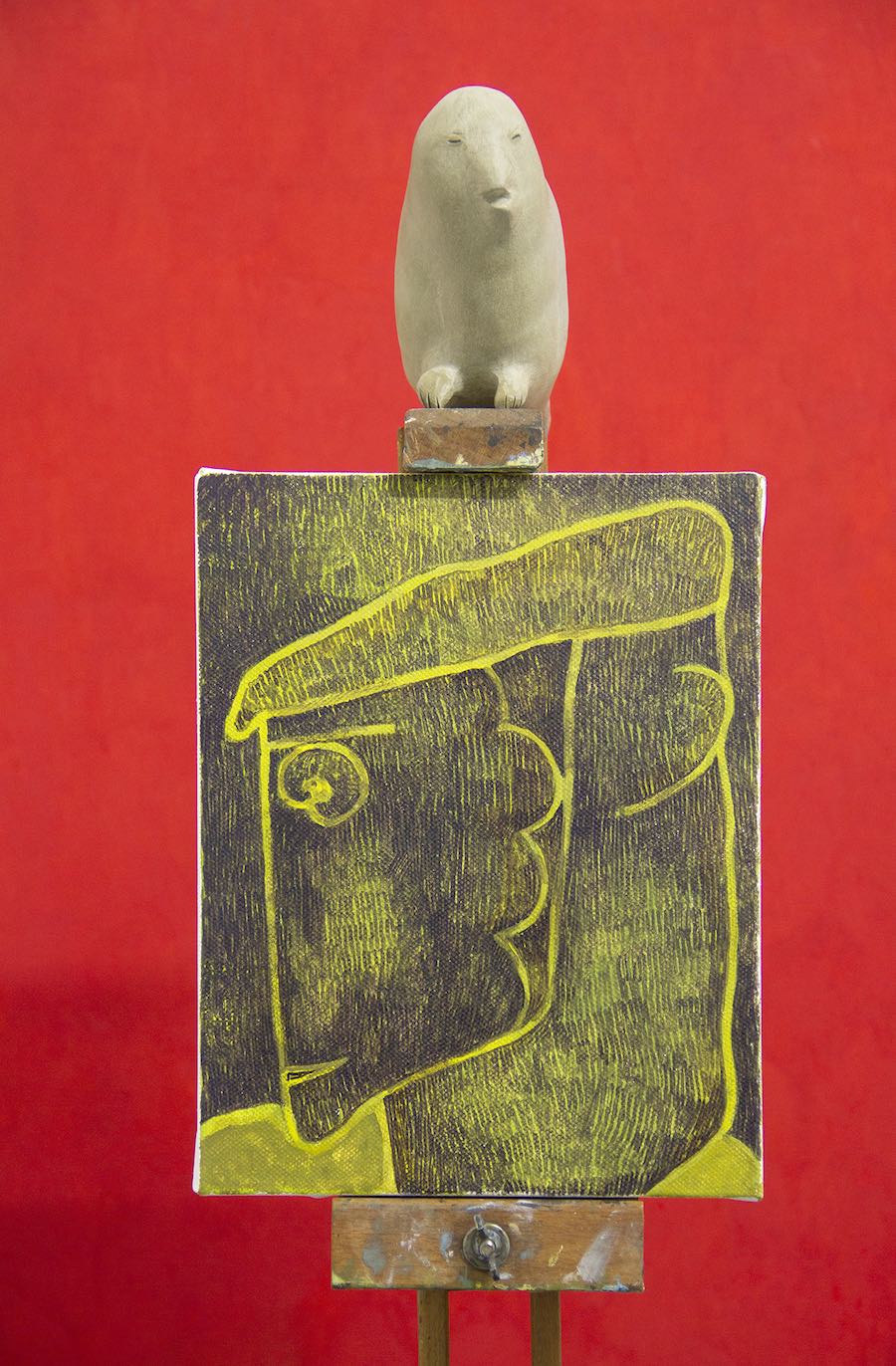
CHAPTER I
WHERE DELTITNU MEETS THE DUCK FOR HIS FIRST STUDIO VISIT
I was very excited about my first studio visit with such an important figure. I had carefully prepared the studio, installing my best works; I knew that the Duck was certainly not a minor professional, on the contrary, she had a lot of influence on the choices of the Director.
I had seen the exhibition she curated shortly before her visit and I was really happy that she had decided to reply to my e-mail. For the occasion I had prepared my delicious biscuits and set up a small exhibition in my studio with a selection of my best works.
What follows is what I remember from our first conversation.
Duck: Hi Deltitnu, I’m happy to meet you in person. It was reasonable of you to invite me to see your work. I am very busy, but I tried my best to be here. This year I am constantly traveling, I leave tomorrow for the Venice Biennale and I have dozens of interviews and studio visits to do.
DELTITNU: It is a pleasure to have you here, thank you for being able to come and see my studio. Would you like something? I have some delicious cookies.
Duck: No. I don’t have much time, let’s go and take care of your work right away. I had a look at the portfolio you sent me; they seemed like good works, but I really need to see them live.
Deltitnu: Here we are in the studio, however I brought the biscuits. I hope you won’t be too harsh in judging my work.
In the following minutes there was a silent conversation between her and my works. A strange wail followed, which I did not understand.
I decided to break the silence to ask her what she thought of my works; but then I felt compelled to tell her something personal, something about me and my works.
As of today, I don’t know why I did it.
Deltitnu: Often I am unable to work, and I try and try again, until I reject the work. These canvases and sculptures were born out of pain. When I made them I was very sick, I wanted to force myself not to have to think. This is how these strange figures are born. They have something in common with death. The two smiling faces are like complementary, and I think they are brothers. But these do not scare me as much as the image of the warrior, which I portrayed in charcoal, in pencil and gouache. He is entirely an image born of my anxieties. I think he’s a guardian, an ancient warrior. It is an image similar to time. I think every image is similar to time, but it is as if I expected this dark face, sooner or later, to start talking to me and making fun of me. And then….
I broke off. The duck’s face was slightly contracted, a slight grimace of her lip revealed an annoyance that was no longer bearable.
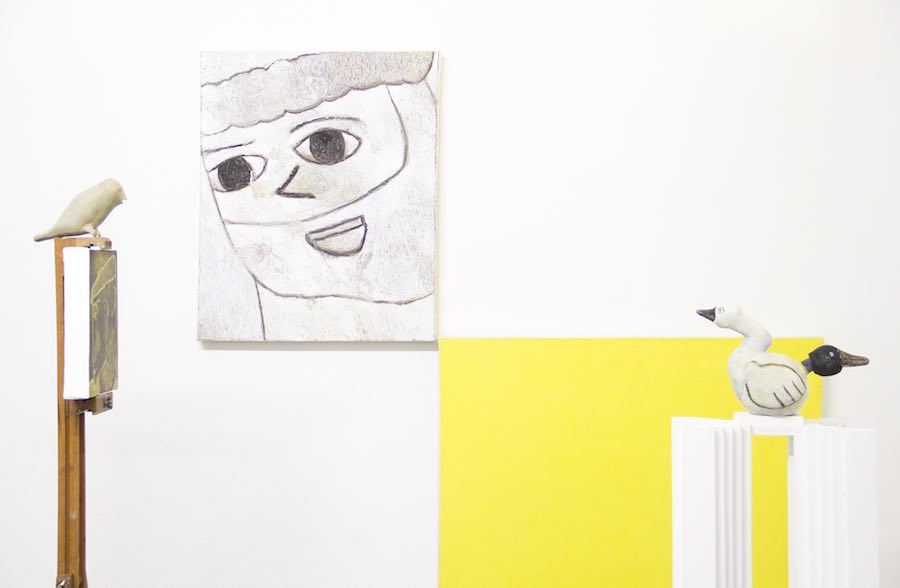

Duck: You are boring, there is too much sentimentality and too much literature in what you say, you have to be simpler, the less you speak the better. The works are also very different from the documentation you sent me. There is some potential, but we need to work on it together.
This cold answer left me blown away. I needed to sit down, but the only chair in the studio was already occupied by the duck.
Duck: Have you already shown these works to anyone before me? Did the Goose see them?
Deltitnu: No, you’re the first one I show them to; I would have shown her to her only later, this is a research that is not yet completely concluded.
Duck: Are you sure it would be a good idea to show them to the Goose? She and I certainly don’t work with the same artists; in case you’d work with her I could never introduce you to the Director. Deltitnu: Why?
Duck: I am not authorized to tell you. I apologized to her.
Duck: You see, dear Deltitnu, there are some unwritten rules. There are many artists and many curators, but not all of them move at the same level. In the art system there are the upper levels, but also the low and sub-order ones: it is good to never get close to the latter if you want to deal with me. For example, do you go to the Director’s openings? I’ve never seen you and he really cares about artists living and experiencing the institutions.
Deltitnu: No, I didn’t know it was that important and almost necessary. But, talking about my works, what do you think? Can we also talk about my research?
Duck: Well, you clearly don’t understand. We are already talking about your research. You claim to be an artist, but at the same time you don’t know the basic rules of art.
I was astonished. Then I remembered the only catalog of an exhibition of some importance in which I had participated and I thought of showing it to her.
I found it under a shelf, but then it seemed like a devious testimony to my research. So I took my hands off the book and left it there.
At that moment I turned and found the duck voraciously eating all the biscuits without saying a word.
Duck: Don’t you understand that I’m the only one who can help you? There are, however, conditions. If the goose were to present your work, you would find the desert around you, the Director has very little consideration for her. Is that what you want?
Deltitnu: Of course not, but could you introduce me to the Director?
Duck: No. Only when he wants it. My job is to get to know and observe the artists and their work, then bring back what I have seen to the highest spheres of art. They will then decide.
What is certain is that you are really naive. I absolutely have to help you look more contemporary. You have to be more cooperative, you have to trust me.
At those words I felt uncomfortable. I felt like I had missed my big break. I had worked so hard on those works and the duck made me feel stupid and unfit. I thought I knew something about art, but from this meeting it became clear to me that this was absolutely not the case.

